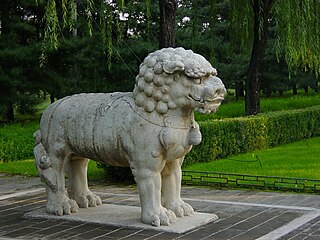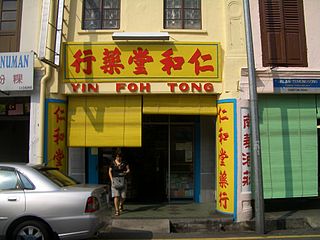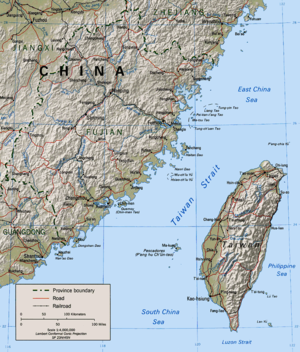Hanyu Pinyin, or simply pinyin, is the most common romanization system for Standard Chinese. In official documents, it is referred to as the Chinese Phonetic Alphabet. Hanyu literally means 'Han language'—that is, the Chinese language—while pinyin literally means 'spelled sounds'. Pinyin is the official romanisation system used in China, Singapore, Taiwan, and by the United Nations. Its use has become common when transliterating Standard Chinese mostly regardless of region, though it is less ubiquitous in Taiwan. It is used to teach Standard Chinese, normally written with Chinese characters, to students already familiar with the Latin alphabet. Pinyin is also used by various input methods on computers and to categorize entries in some Chinese dictionaries.

In linguistics, romanization is the conversion of text from a different writing system to the Roman (Latin) script, or a system for doing so. Methods of romanization include transliteration, for representing written text, and transcription, for representing the spoken word, and combinations of both. Transcription methods can be subdivided into phonemic transcription, which records the phonemes or units of semantic meaning in speech, and more strict phonetic transcription, which records speech sounds with precision.
Mandarin Phonetic Symbols II is a romanization system formerly used in Taiwan. It was created to replace the complex Gwoyeu Romatzyh system, which used tonal spelling—and to co-exist with the Wade–Giles romanization as well as bopomofo. It is sometimes referred to as Gwoyeu Romatzyh 2 or GR2.

Postal romanization was a system of transliterating place names in China developed by postal authorities in the late 19th and early 20th centuries. For many cities, the corresponding postal romanization was the most common English-language form of the city's name from the 1890s until the 1980s, when postal romanization was replaced by pinyin, but the system remained in place on Taiwan until 2002.
Tongyong Pinyin was the official romanization of Mandarin in Taiwan between 2002 and 2008. The system was unofficially used between 2000 and 2002, when a new romanization system for Taiwan was being evaluated for adoption. Taiwan's Ministry of Education approved the system in 2002, but its use was optional.

Gwoyeu Romatzyh is a system for writing Standard Chinese using the Latin alphabet. It was primarily conceived by Yuen Ren Chao (1892–1982), who led a group of linguists on the National Languages Committee in refining the system between 1925 and 1926. In September 1928, it was adopted by the Republic of China as the national romanization system for Standard Chinese. GR indicates the four tones of Standard Chinese by varying the spelling of syllables, a method originally proposed by team member Lin Yutang (1895–1976). Distinct sets of spellings are assigned to syllables in GR according to particular rules. This differs from approaches used by other systems to denote tones, like the numerals used by the earlier Wade–Giles system, or the diacritics used by the later Hanyu Pinyin system.

"Lion-Eating Poet in the Stone Den" is a short narrative poem written in Literary Chinese, composed of around 92 to 94 characters in which every word is pronounced shi when read in modern Standard Chinese, with only the tones differing.
Latinxua Sin Wenz is a historical set of romanizations for Chinese. Promoted as a revolutionary reform to combat illiteracy and replace Chinese characters, Sin Wenz distinctively does not indicate tones, for pragmatic reasons and to encourage the use of everyday colloquial language. Beifangxua Latinxua Sin Wenz, for Mandarin Chinese, was the original iteration, and a number of variations for various varieties of Chinese were developed by regional Sin Wenz associations.
General Chinese is a diaphonemic orthography invented by Yuen Ren Chao to represent the pronunciations of all major varieties of Chinese simultaneously. It is "the most complete genuine Chinese diasystem yet published". It can also be used for the Korean, Japanese, and Vietnamese pronunciations of Chinese characters, and challenges the claim that Chinese characters are required for interdialectal communication in written Chinese.
Tone numbers are numerical digits used like letters to mark the tones of a language. The number is usually placed after a romanized syllable. Tone numbers are defined for a particular language, so they have little meaning between languages.
The SASM/GNC/SRC romanization of Standard Tibetan, commonly known as Tibetan pinyin or ZWPY, is the official transcription system for the Tibetan language in China. It is based on the pronunciation used by China National Radio's Tibetan Radio, which is based on the Lhasa dialect. It has been used within China as an alternative to the Wylie transliteration for writing Tibetan in the Latin script since 1982.

Romanization of Chinese is the use of the Latin alphabet to transliterate Chinese. Chinese uses a logographic script and its characters do not represent phonemes directly. There have been many systems using Roman characters to represent Chinese throughout history. Linguist Daniel Kane wrote, "It used to be said that sinologists had to be like musicians, who might compose in one key and readily transcribe into other keys." The dominant international standard for Standard Mandarin since about 1982 has been Hanyu Pinyin, invented by a group of Chinese linguists, including Zhou Youguang, in the 1950s. Other well-known systems include Wade–Giles and Yale romanization.
There are many romanization systems used in Taiwan. The first Chinese language romanization system in Taiwan, Pe̍h-ōe-jī, was developed for Taiwanese by Presbyterian missionaries and has been promoted by the indigenous Presbyterian Churches since the 19th century. Pe̍h-ōe-jī is also the first written system of Taiwanese Hokkien; a similar system for Hakka was also developed at that time. During the period of Japanese rule, the promotion of roman writing systems was suppressed under the Dōka and Kōminka policy. After World War II, Taiwan was handed over from Japan to the Republic of China in 1945. The romanization of Mandarin Chinese was also introduced to Taiwan as official or semi-official standard.
The spelling of Gwoyeu Romatzyh (GR) can be divided into its treatment of initials, finals and tones. GR uses contrasting unvoiced/voiced pairs of consonants to represent aspirated and unaspirated initials in Chinese: for example b and p represent IPA [p] and [pʰ]. The letters j, ch and sh represent two different series of initials: the alveolo-palatal and the retroflex sounds. Although these spellings create no ambiguity in practice, readers more familiar with Pinyin should pay particular attention to them: GR ju, for example, corresponds to Pinyin zhu, not ju.
Simplified Wade, abbreviated SW, is a modification of the Wade–Giles romanization system for writing Standard Mandarin Chinese. It was devised by the Swedish linguist Olov Bertil Anderson (1920–1993), who first published the system in 1969. Simplified Wade uses tonal spelling: in other words it modifies the letters in a syllable in order to indicate tone differences. It is one of only two Mandarin romanization systems that indicate tones in such a way. All other systems use diacritics or numbers to indicate tone.
Bopomofo, also called Zhuyin Fuhao, or simply Zhuyin, is a transliteration system for Standard Chinese and other Sinitic languages. It is the principal method of teaching Chinese Mandarin pronunciation in Taiwan. It consists of 37 characters and five tone marks, which together can transcribe all possible sounds in Mandarin Chinese.

The different varieties of Chinese have been transcribed into many other writing systems.
The phonology of Standard Chinese has historically derived from the Beijing dialect of Mandarin. However, pronunciation varies widely among speakers, who may introduce elements of their local varieties. Television and radio announcers are chosen for their ability to affect a standard accent. Elements of the sound system include not only the segments—e.g. vowels and consonants—of the language, but also the tones applied to each syllable. In addition to its four main tones, Standard Chinese has a neutral tone that appears on weak syllables.
The Yale romanization of Mandarin is a system for transcribing the sounds of Standard Chinese, based on the Beijing dialect of Mandarin. It was devised in 1943 by the Yale sinologist George Kennedy for a course teaching Chinese to American soldiers, and was popularized by continued development of that course at Yale. The system approximated Chinese sounds using English spelling conventions, in order to accelerate acquisition of correct pronunciation by English speakers.









